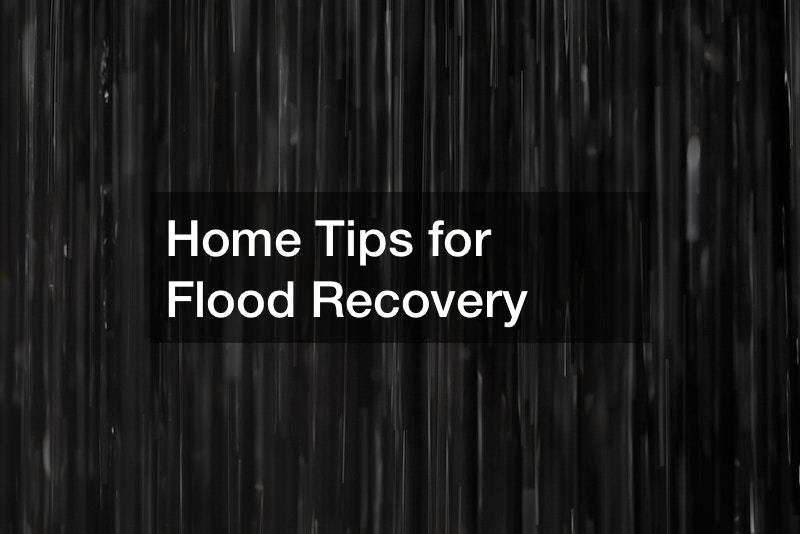
Floods in the home can occur for several reasons. Some places are more prone to floods than others, referred to as floodplains. They can occur following heavy rains, thunderstorms, or flash floods where adjacent water infiltrates the home. Floods could also result from strong winds like hurricanes, tornados, or tropical cyclones.
Floods in the home also happen due to damages such as burst pipes. In some cases, it could be due to human error. Say you’re going on vacation and forget to turn off the faucet in the bathroom or kitchen. Unless you have good neighbors, you’ll come back to a drenched home.
Whichever way it happens, a flooded home is hazardous to live in, and if you don’t address the damages promptly and correctly, it could lead to irreversible damage. If such misfortune has befallen you, you may be left wondering how to go about repairs. Here are tips for how to approach house damage repair after a flood.
1. Stop the Source of the Flood

Even if you think the damage to your home isn’t substantial, you first want to ensure it’s safe. If the flood you’re experiencing results from damage within the house, you should first identify where it’s coming from and stop the water from flowing. If the water flows from your sink or toilet, there’s often a shut-off nearby. If you can’t locate the source of the water, shut the water from the main valve. If that fails, call a plumber immediately.
2. Electric and Gas Line
Electrical hazards are one of the most significant dangers in the home after a flood. Depending on the depth of the flood water, if it has gotten above your electrical outlets, or the water has been sitting in your house for a while and sipped through porous walls, don’t go back inside the house until a professional electrician has assessed it, live currents are disconnected, electrical appliances are unplugged and, the gas line turned off. Only go back in to start planning for house damage repair after the electrician declares your house safe.
3. Insurance

The next thing you should do is call your insurance company. You should contact them within twenty-four hours to file a claim for the damage. Make sure to document what has happened to the house by taking pictures and videos before you can attempt any house damage repair. In case of a continuous flood, make sure to document daily and consistently.
It’s important to note that you can only assess and document what you see. Sometimes the damage may not seem so bad, but if the pipe burst happens, say on the third or second floor of your house, and the water flows down between the walls, the damage will be inside the walls and under the floors, invisible to you and may be more extensive than you can capture. Your insurance company will have moisture-detecting equipment for those types of assessments.
Insurance companies use three key points to determine substantial damage. First, they’ll assess the depth of flooding by checking for watermarks using survey equipment. Next, they’ll establish the value of the structure itself, which is your house, in this case, at current market value pre-flood. They won’t factor in the value of the land. Thirdly, the value of house damage repair needed to restore the house to its pre-disaster condition.
The current local labor and material cost determine the repair costs. They then compare the structure’s value vis-a-vis that of the improvements, and if the latter is more than fifty percent or more than the value of the former, the structure is considered substantially damaged. They generally have a per-square-foot cost per six inches of flooding. As the homeowner, you should communicate with the contractor and the insurance adjuster and work as a team to determine how to address damages.
4. Clean Out

If it’s safe to be in the house and you are doing the cleanup yourself, wear personal protective equipment. Masks are essential since there are bound to be all types of contaminants in the air. Invest in an N-100 respirator for maximum protection. Use disposable gloves, rubber boots, and clothes since flood water often gets mixed with sewer water, and bacterial issues loom. If the damage is extensive, call in a remediation company to come and clean up.
Before you can start determining which items to get rid of or not, you must first move your belongings out of the house to a safe and dry place. If the depth of the water is below most of your furniture, consider elevating them instead of moving them outside. In any other case, you’ll have to move all your furniture out. You may need to look up and contract moving businesses since, most often than not, you’ll need to relocate for some time to allow for house damage repair.
Look at the flood line of the house. Depending on how high the water got, you can see a dirt line on the walls. Mark a foot above that flood line. You’ll need to trash anything below that. If you have carpeted floors, you should remove those along with the carpet padding. After a flood, it is hard to dry and reuse them, so you’ll need to toss them.
Cut through the soaked sheetrock and trim boards since they will typically swell up, along with everything else that has absorbed that water, like insulation. You can’t save them. Once you’ve placed your belongings where you can assess the damage, get rid of things you can’t salvage. You may have to throw out a lot of stuff, but you’ll be covered as long as you have insurance.
Along with everything else you will sweep out of the house, fitting everything into your single-unit bin will likely be impossible. You’ll need a dumpster rental. The size and depth of roll-off dumpsters make them convenient for large cleanups like storm damage cleanup and junk and trash removal. According to BigRentz, the cost of dumpster rentals depends on factors such as location, size, duration of the rental, and type of garbage. On average, it costs $40, and the weekly cost for a ten-yard dumpster ranges from $150 to $1000.
To eliminate the debris, silt, and bacteria, you may need to hose down your house and thoroughly clean it with anti-bacterial agents. For mold remediation, use bleach and water solution for non-porous surfaces like concrete and straight white vinegar for those porous surfaces, like your two-by-fours or trim boards, which will soak through and prevent mold and mildew. You can also purchase an anti-microbial spray which will also do the trick. Consider applying a borate treatment to exposed wood, which deters both mold and decay.
5. Ventilate and Dehumidify
Within twenty-four and forty-eight hours, mold can start forming due to the moist, wet, and warm conditions. So if your curtains are soaked up, remove them and any other fabric material. Even if you think things are nice and dry, keep drying them up to keep mold and mildew at bay to avoid high house damage repair costs later. Next, open the windows and doors if the weather is conducive, and keep them open.
Use a carpet dryer or fan to keep the air in your home moving to maintain indoor air quality. If you have wet lumber or any hard surface, like man-made hardwood may be salvaged if they get enough airflow. If there’s no sun to dry everything out, you’ll need to close your windows and use a de-humidifier. This will get rid of the musty smell as well as eliminate the risk of dust mites, which are the leading cause of asthma.
After your efforts, verify that your house is dry. Make sure any wood inside is 16% moisture content or less; you can use a moisture meter for that. Consider hiring professionals before embarking on any house damage repair.
6. Reconstruction
Once the house is clean and dry, it’s time to get to the house damage repair work. If you have insurance, your provider will cover the costs for reconstruction. Go for flood-resistant material this time in case there is a next time. While you’re in the process of reconstructing, consider installing a Radon mitigation system since this radioactive gas from the soil might build up in your house.
Flood house damage repair can be done by a professional like a home remodeling contractor. However, for such a specific event, you want to work with flood damage restoration companies with experience in this type of work, as they’ll have some tricks up their sleeves. Flood remediation service will take care of hiring contractors since you’ll likely need them simultaneously.
Your floor can use new covering if completely dry. The walls will need a lot of work, from insulation to wall cover like wood and so on, to finishes like painting, which you should consider getting painting services for a polished final look. Consider increasing the R-value in the walls by installing a closed spray form or a cell-closed rigid foam board. For door and window frames, use fiberglass or vinyl frames which are non-absorbent and energy efficient.
Having assessed damage earlier, check the roof and reinforce it for leeks. Ensure the water collection connection is repaired. Hire professional gutter services for an effective job. The basement is one of the most affected areas of a home after a flood, so remember to hire contractors for your basement restoration.
7. Flood Proofing
Whether your home is in a flood plain or not, it’s important to floodproof your home. House damage repair costs can be lowered or even reduced to zero with all the floodproofing technology available today. Install floodgates or flood barriers to protect your home from recurrent floods. Reitthaler is a German company that makes sophisticated automated barriers that are installed under the floor in a driveway or even the front door. These barriers rise from the ground to block the water by using special sensors activated by water that exceeds a certain level.
The barriers are designed for water levels of up to 32 inches and continue to work even when the power is out. Levees and floodwalls like counterfort, buttress, cantilever, and gravity, which have been tried and tested, are also great investments. Protection can extend to your car. By getting a flood guard, your car will have a protective cover which is an air-tight bag impervious to water.
It can also protect your car surfaces from debris floating around and features special cushions on the outside that absorb impact energy in the event of a collision. Installation is as simple as unwrapping the floor guard, parking your car inside the cover, attaching the cover to the car, and closing the zipper. Your car can also be attached to sturdier structures with additional straps.
Topmix permeable paving concrete is a British invention for alternative road materials that have excellent drainage properties. Conventional concrete can only absorb a limited amount of water, and the excess remains on the surface, forming puddles. In contrast, one square meter of Topmix can absorb up to 264 gallons of water in a minute. It is, therefore, ideal for parking lots, walkways, and pavements to avoid the effects of flooding in urban areas.
Handling a Flooded Home

Dealing with a flooded home is a huge, costly, and hazardous ordeal. However, it can also be an opportunity to do more than restore your home but also improve it, especially if your house is outdated. If you live in a flood plain, prioritize getting flood-hardy materials, especially in the lower level of your house, while taking advantage of all the advanced technology available to floodproof your home.
Familiarize yourself with the floodplain rules of developing property so you’re covered after the inevitable happens and don’t incur preventable house damage repair costs. Most importantly, protect yourself from harm like lead poisoning from all that dust and chipping paint while restoring your home. Take precautions, especially if you’ll be the one performing the cleaning, by getting your tetanus shot and a booster when required to protect you from infections through contamination from the flood waters.



